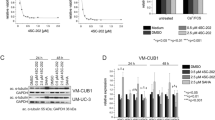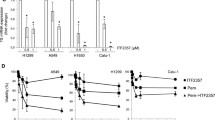Abstract
Histone deacetylase inhibitors (HDACIs) exhibit modest results as single agents in preclinical and clinical studies against solid tumors; they often fall short and activate nuclear factor kappa-B (NFκB). Co-administration of HDACI with proteasome inhibitors (PIs), which interrupt NFκB pathways, may enhance HDACI-lethality. The goal of this study was to determine whether PIs could potentiate HDACI, scriptaid (SCP)-mediated lethality, to unravel the associated mechanisms and to assess the effects of the combined inhibition of HDAC and proteasome on chemotherapy response in human colorectal cancer cells. Cancer cells were exposed to agents alone or in combination; cell growth inhibition was determined by MTT and colony formation assays. HDAC-, proteasome-, NFκB-activities, and reactive oxygen species (ROS) were quantified. Induction of apoptosis and cell cycle alterations were monitored by flow cytometry. Expression of cell cycle/apoptosis and cytoprotective/stress-related genes was determined by real-time qRT-PCR and EIA, respectively. Potentiation of cancer cell sensitivity to chemotherapies by SCP/PIs was also evaluated. SCP and PIs: MG132, PI-1, or epoxomicin interact synergistically to potently inhibit cancer cell growth, alter cell cycle, induce apoptosis, reduce NFκB activity, and increase ROS generation. These events are associated with multiple perturbations in the expression of cell cycle, apoptosis, cytoprotective, and stress-related genes. Co-administration of SCP and PIs strikingly increases the chemosensitivity of cancer cells (122–2 × 105-fold) in a drug and SCP/PIs-dependent manner. This combination regimen markedly reduced the doses of chemotherapies with potent anticancer effects and less toxicity. A strategy combining HDAC/proteasome inhibition with chemotherapies warrants further investigation in colorectal cancer.










Similar content being viewed by others
References
Ellis L, Hammers H, Pili R. Targeting tumor angiogenesis with histone deacetylase inhibitors. Cancer Lett. 2009;280:145–53.
Monneret C. Histone deacetylase inhibitors. Eur J Med Chem. 2005;40:1–13.
Su GH, Sohn TA, Ryu B, Kern SE. A novel histone deacetylase inhibitor identified by high-throughput transcriptional screening of a computer library. Cancer Res. 2000;60:3137–42.
Takai N, Ueda T, Nishida M, Nasu K, Narahara H. A novel histone deacetylase inhibitor, Scriptaid, induces growth inhibition, cell cycle arrest and apoptosis in human endometrial cancer and ovarian cancer cells. Int J Mol Med. 2006;17:323–9.
Ellis L, Pili R. Histone deacetylase inhibitors: advancing therapeutic strategies in hematological and solid malignancies. Pharmaceuticals (Basel). 2010;3(8):2411–69.
Mayo MW, Denlinger CE, Broad RM, Yeung F, Reilly ET, Shi Y, Jones DR. Ineffectiveness of histone deacetylase inhibitors to induce apoptosis involves the transcriptional activation of NF-kappa B through the Akt pathway. J Biol Chem. 2003;278:18980–9.
Dai Y, Rahamani M, Dent P, Grant S. Blockade of histone deacetylase inhibitor-induced Rel A/p65 acetylation and NF-κB activation potentiate apoptosis in leukemia cells through a process mediated by oxidative damage, XIAP downregulation, and c-Jun N-terminal kinase 1 activation. Mol Cell Biol. 2005;25:5429–44.
Adams J, Palombella VJ, Elliot PJ. Proteasome inhibition: a new strategy in cancer treatment. Investig New Drugs. 2000;18:109–21.
Almond JB, Cohen GM. The proteasome: a novel target for cancer chemotherapy. Leukemia. 2002;16:433–43.
An B, Goldfarb RH, Dou QP. Novel dipeptidyl proteasome inhibitors overcome Bcl-2 protective function and selectively accumulate the cyclin-dependent kinase inhibitor p27 and induce apoptosis in transformed, but not normal, human fibroblasts. Cell Death Diff. 1998;5:1062–75.
Cusack Jr JC, Liu R, Houston M, et al. Enhanced chemosensitivity to CPT-11 with proteasome inhibitor PS-341: implication for systemic nuclear factor-kappaB inhibition. Cancer Res. 2001;61:3535–40.
Abaza MS, Al-Safar A, Al-Sawan S, Al-Attiyah R. c-myc antisense oligonucleotides sensitize human colorectal cancer cells to chemotherapeutic drugs. Tumor Biol. 2008;29:287–303.
Abaza MSI. Augmentation of the anticancer effects of proteasome inhibitors by combination with sodium butyrate in human colorectal cancer cells. Experimental and Therapeutic Medicine. 2010;1:675–93.
Jones PA, Baylin SB. The epigenomics of cancer. Cell. 2007;128:683–92.
Bolden JE, Perat MJ, Johnstone RW. Anticancer activities of histone deacetylase inhibitors. Nat Rev Drug Discov. 2006;5:769–84.
Xu WS, Parmigiani RB, Marks PA. Histone deacetylase inhibitors: molecular mechanisms of action. Oncogene. 2007;26:5541–52.
Xu W, Ngo L, Perez G, Dokmanovic M, Marks PA. Intrinsic apoptotic and thioredoxin pathways in human prostate cancer cell response to histone deacetylase inhibitor. Proc Natl Acad Sci USA. 2006;103:15540–5.
Bots M, Johnstone RW. Rational combinations using HDAC inhibitors. Clin Cancer Res. 2009;15:3970–7.
Rasheed W, Bishton M, Johnstone RW, Prince HM. Histone deacetylase inhibitors in lymphoma and solid malignancies. Expert Rev Anticancer Ther. 2008;8:413–32.
Frew AJ, Johnstone RW, Bolden JE. Enhancing the apoptotic and therapeutic effects of HDAC inhibitors. Cancer Lett. 2008;125:125–33.
Denlinger C, Keller M, Mayo M, Broad RM, Jones DR. Combined proteasome and histone deacetylase inhibition in non-small cell lung cancer. J Thorac Cardiovasc Surg. 2004;127:1078–86.
Bhalla S, Balasubramanian S, David K, et al. PCI-24781 induces caspase and reactive oxygen species-dependent apoptosis through NFκB mechanisms and is synergistic with bortezomib in lymphoma cells. Clin Cancer Res. 2009;15:3354–65.
Dasmahapatra G, Lembersky D, Son MP, Attkisson E, Dent P, Fisher RI, Friedberg JW, Grant S. Carfilzomib interacts synergistically with histone deacetylase inhibitors in mantle cell lymphoma cells in vitro and in vivo. Mol Cancer Ther. 2011;10:1686–97.
Vigushin DM, Coomes RC. Histone deacetylase inhibitors in cancer treatment. Anticancer Drugs. 2002;13:1–13.
Butler LM, Zhou X, Xu WS, Scher HI, Rifkind RA, Marks PA, et al. The histone deacetylase inhibitor SAHA arrests cancer cell growth, up-regulates thioredoxin-binding protein-2, and down-regulates thioredoxin. Proc Natl Acad Sci USA. 2002;99:11700–5.
Duan J, Friedman J, Nottingham L, Chen Z, Ara G, Van Waes C. Nuclear factor-κ p65 small interfering RNA or proteasome inhibitor bortezomib sensitizes head and neck squamous cell carcinomas to classic histone deacetylae inhibitors and novel histone deacetylase inhibitor PXD101. Mol Cancer Ther. 2007;6:37–50.
Adams J. Development of the proteasome inhibitors PS-341. Oncologist. 2002;7:9–16.
Denlinger CE, Mayo MW, Jones DR. Combination proteasome inhibition and gemcitabine chemo-sensitizes NSCLC to apoptosis by inhibition of NFκB. Proc Am Assoc Cancer Res. 2003;44:1058.
Zhang QL, Wang L, Zhang YW, Jiang XX, Yang F, Wu WL, Janin A, Chen Z, Shen ZX, Chen SJ, Zhao WL. The proteasome inhibitor bortezomib interacts synergistically with histone deacetylase inhibitor suberoylanilide hydroxamic acid to induce T-leukemia/lymphoma cells apoptosis. Leukemia. 2009;23:1507–14.
Heider U, von Metzler I, Kaiser M, et al. Synergistic interaction of the histone deacetylase inhibitor SAHA with the proteasome bortezomib in mantle cell lymphoma. Eur J Haematol. 2008;80:133–42.
Ruefli AA, Ausserlechner MJ, Bernhard D, et al. The histone deacetylase inhibitor and chemotherapeutic agent suberoylanilide hydroxamic acid (SAHA) induces a cell-death pathway characterized by cleavage of Bid and production of reactive oxygen species. Proc Natl Acad Sci USA. 2001;98:10833–8.
Heider U, Rademacher J, Lamottke B, Mieth M, Moebs M, von Metzler I, Assaf C, Sezer O. Synergistic interaction of the deacetylase inhibitor SAHA with the proteasome inhibitor bortezomib in cutaneous T cell lymphoma. Eur J Haematol. 2009;82:440–9.
Flis S, Gnyszka A, Splawinski J. HDAC inhibitors, MS275 and SBHA, enhances cytotoxicity induced by oxaliplatin in the colorectal cancer cell lines. Biochem Biophys Res Comm. 2009;387:336–41.
Sharma V, Koul N, Joseph C, Dixit D, Ghosh S, Sen E. HDAC inhibitor, scriptaid, induces glioma cell apoptosis through JNK activation and inhibits telomerase activity. J Cell Mol Med. 2010;14:2151–61.
Orlowski RZ. The role of ubiquitin–proteasome pathway in apoptosis. Cell Death Diff. 1999;6:303–31.
Pagabo M, Tam SW, Theodoras AM, Beer-Romero P, Del Sal G, Chau V, Yew PR. PR, et al. Role of the ubiquitin–proteasome pathway in regulating abundance of the cyclin-dependent kinase inhibitor p27. Science. 1995;269:682–5.
Chen YR, Wang X, Templeton D, Davis RJ, Tan TH. The role of c-jun N-terminal kinase (JNK) in apoptosis induced by ultraviolet C and γ radiation. Duration of JNK activation may determine cell death and proliferation. J Biol Chem. 1996;271:31929–36.
Nawrocki ST, Carew JS, Pino MS, et al. Aggresome disruption: a novel strategy to enhance bortezomib-induced apoptosis in pancreatic cancer cells. Cancer Res. 2006;66:3773–81.
Xia Z, Dickens M, Raingeaud J, Davis RJ, Greenberg ME. Opposing effects of ERK and JNK-p38 MAP kinases on apoptosis. Science 1995;270:1326–31.
Toumier C, Hess P, Yang DD, et al. The Bax subfamily of Bcl2 related proteins is essential for apoptotic signal transduction by c-Jun NH2-terminal kinase. Mol Cell Biol. 2002;22:4929–42.
Tacchini L, Dansi P, Matteucci E, Bemelli-Zazzera A, Desiderio MA. Influence of proteasome and redox state on heat shock-induced activation of stress kinases, AP-1 and HSF. Biochim Biophy Acta. 2001;1538:76–89.
Shelton JG, Blalock WL, White ER, Steelman LS, McCubrey JA. Ability of the activated PI3/AKT oncoproteins to synergize with MEK1 and induce cell cycle progression and abrogate the cytokine-dependence of hematopoietic cells. Cell Cycle. 2004;3:503–12.
Baldini E, Gardin G, Giannessi P, Brema F, Camorriano A, Carnino F, Naso C, Pastorino G, Pronzato P, Rosso R, Rubagotti A, Torreta G, Conte PF. A randomized trial of chemotherapy with or without estrogenic recruitment in locally advanced breast cancer. North-West Oncology Group (GONO) study, Italy. Tumori. 1997;83:829–33.
Wang CY, Cusack Jr JC, Liu R, Baldwin Jr AS. Control of inducible chemoresistance: enhanced anti-tumor therapy through increased apoptosis by inhibition of NFκB. Nat Med. 1999;5:412–7.
Vanden Berghe W, Francesconi E, De Bosscher K, Resche Rigon M, Haegeman G. Dissociated glucocorticoids with anti inflammatory potential repress interleukin-6 gene expression by a nuclear factor-κB-dependent mechanism. Mol Pharmacol. 1999;56:797–806.
Mellits KH, Hay RT, Goodbourn S. Proteolytic degradation of MAD3 (IκBα) and enhanced processing of the NFκB precursor p105 steps in the activation of NFκB. Nucleic Acids Res. 1993;21:5059–66.
Huong PT, Moon DO, Kim KE, Jeong SJ, Lee KW, Lee KS, Jang JH, Erikson RL, Ahn JS, Kim BY. Proteasome inhibitor-I enhances tunicamycin-induced chemosensitization of prostate cancer cells through regulation of NFκB and CHOP expression. Cell Signal. 2011;23:857–65.
O'Connor OA, Wright J, Moskowitz C, et al. Phase II clinical experience with the novel proteasome inhibitor bortezomib in patients with indolent non-Hodgkin's lymphoma and mantle cell lymphoma. J Clin Oncol. 2005;23:676–84.
Acknowledgment
This study was supported by Kuwait University, Research Grant, No. [SL05-05].
Conflicts of interest
None
Author information
Authors and Affiliations
Corresponding author
Rights and permissions
About this article
Cite this article
Abaza, M.S.I., Bahman, A.M., Al-Attiyah, R.J. et al. Synergistic induction of apoptosis and chemosensitization of human colorectal cancer cells by histone deacetylase inhibitor, scriptaid, and proteasome inhibitors: potential mechanisms of action. Tumor Biol. 33, 1951–1972 (2012). https://doi.org/10.1007/s13277-012-0456-6
Received:
Accepted:
Published:
Issue Date:
DOI: https://doi.org/10.1007/s13277-012-0456-6




